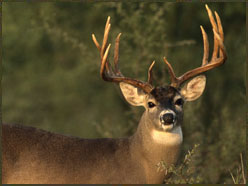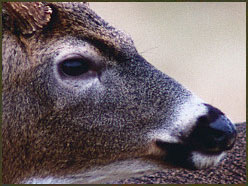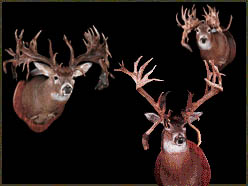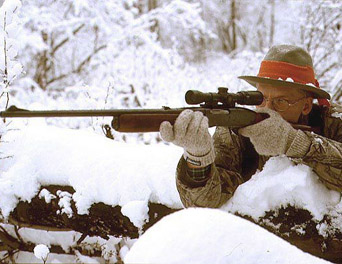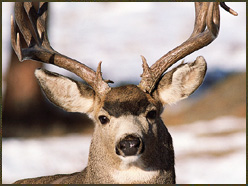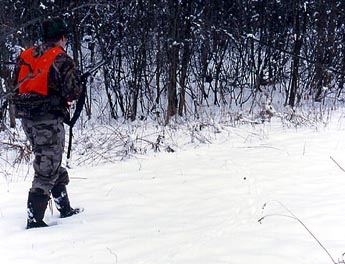For most of the animal world, glandular secretions and scent-marking play a more important communication role than visual signals and vocalizations do. The latter serve only short-term and short-range purposes, while scent marks provide an extension of the animal itself and remain functional long after the maker has left the scene.
In the first part of this two-part series, we’ll take an in-depth look at one of the whitetail deer’s two primary scent-marking behaviors: antler rubbing. In the next issue, we’ll make a similar analysis of whitetail scrapes.
Why Are Rubs Made?
Very few buck rubs are made by deer removing antler velvet, a process that’s normally completed within 24 hours. Instead, most rubs are made by relatively few dominant bucks to signal their readiness to breed and to proclaim their control over a given area.
Rubs are intended to be eye-catching. But they’re also anointed with the maker’s distinctive scent. All whitetails possess specialized forehead skin glands that become increasingly active in autumn. And tests indicate that mature, socially high-ranking bucks exude greater amounts of the glandular secretion than do younger males or females.
While dominant bucks are the primary signpost makers and message “senders” within a whitetail herd, young males and females are the primary message “readers.” The chemical signals exchanged at a rub tend to suppress the aggressiveness and sex drive of young males. However, those same signals stimulate females and help synchronize breeding cycles. As a result, the presence of older bucks and their signposts helps maintain social order in a given area.
What Do Deer Rub on?
When they’re in the mood, whitetail bucks will rub just about anything, including fence posts and powerline poles. But they prefer to rub trees and shrubs that have smooth bark and no lower limbs and are one-half to four inches in diameter.
In the Southeast, bucks seem to prefer aromatic species, such as cedar and sassafras. However, they’ll also readily rub alders, cherries, eastern juniper, witch hazel, winged sumac, sourwood, striped maple and pines.
Trembling aspen is the preferred species for rubbing in the Northeast and Upper Great Lakes region. In its early stages of growth, the species has a smooth, soft bark that is easily stripped. Its inner wood is very lightly colored and has a long-lasting brilliance once it’s exposed. Staghorn sumac, red maple, black cherry, balsam fir, pines and willows are also frequently rubbed, whereas sugar maple, ironwood, beech and paper birch are usually avoided.
All bucks occasionally rub saplings less than two inches in diameter, but only older bucks regularly rub trees six or more inches in diameter. In addition, young bucks seldom re-rub the same tree. So, if you happen upon a large-diameter tree that shows signs of frequent rubbing, you can be sure that at least one older, rut-experienced buck is in the area.
When Do Deer Rub?
The timing of velvet shedding-and subsequent rubbing-is physiologically triggered by the shortening days of autumn. Aside from a more prolonged velvet-shedding season in the South, peak shedding dates normally vary by only a few weeks anywhere in the U.S. In the northern range, bucks generally rub off velvet during late August and early September, nearly two months before the first does breed. In the South, mature bucks tend to strip velvet around the middle of September. Exceptions in all portions of the nation occur with young bucks and with unhealthy mature deer, both of which may experience a delay of several weeks in shed timing.
Mature dominant bucks begin marking their territory soon after losing velvet and continue marking until they cast their antlers. By comparison, yearlings and 21/2-year-old bucks have little status or rank to advertise. They enter rutting condition later thhan older males. Even when there are no mature bucks around, yearlings make only about half as many total rubs as prime-age whitetails. Consequently, serious signpost rubbing in September is almost always evidence of a big buck’s presence.
How Much Do Deer Rub?
The amount of rubbing an individual buck does depends on the level of testosterone (the male sex hormone) in his blood, which in turn is largely determined by the animal’s age and dominance status. Prime-age bucks in good condition are the first to reach the threshold levels of testosterone that cause velvet shedding. They also achieve higher concentrations of the hormone, which contribute to their extreme aggressiveness, higher social rank and tendency to make more rubs.
On healthy deer ranges, rub densities can vary from a couple hundred to nearly 5,000 per square mile and are closely related to the number of older bucks in the population. Even a fairly large number of young bucks may make few total rubs relative to what a couple of older bucks in the same area can produce. There are other factors contributing to rub densities in a given area, including the nutritional status of the deer herd. If you’re having a hard time finding rubs during your scouting, take a close look under oaks and other mast-producing trees. More rubs are made in years when acorns are abundant than when they are not.
Where Do Deer Rub?
As the rut approaches, a dominant buck shifts his habits to interact with other deer over a breeding range of anywhere from one to five square miles. Bucks in the North tend to travel larger autumn ranges when deer density is low. In the South, they’re more apt to cover less area, especially where deer are plentiful.
Clusters of buck rubs are most likely to occur in habitats close to areas with abundant seasonal food, such as wooded cover near corn or alfalfa fields, oak habitat in years when acorns are abundant and areas adjacent to forest openings or near artificial feeders and food plots. Such rubbing strategy makes good sense, of course, because other deer will probably concentrate near such choice feeding sites, making a buck’s signposting most effective.
Also look for rubs along travel corridors-deer trails, ridgetops, old logging roads and in swales at stream crossings. If you find a cluster of rubs in a secluded patch of heavy cover you may have stumbled upon a favorite bedding area of an older buck.
